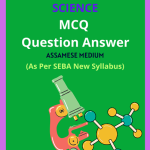Class 8 Science MCQ Chapter 15 Some Natural Phenomena Solutions in English Medium, Class 8 Science Multiple Choice Question Answer in English to each chapter is provided in the list so that you can easily browse throughout different chapters Class 8 Science MCQ Chapter 15 Some Natural Phenomena Notes and select need one.
Class 8 Science MCQ Chapter 15 Some Natural Phenomena
Also, you can read the SCERT book online in these sections Class 8 Science Objective Type Solutions by Expert Teachers as per SCERT (CBSE) Book guidelines. These solutions are part of SCERT All Subject Solutions. Here we have given Assam Class 8 Science MCQs Solutions in English for All Subject, You can practice these here.
Some Natural Phenomena
Chapter – 15
| MCQ |
1. It is a convention to call the charge acquired by a glass rod when it is rubbed with silk as-
(a) Negative.
(b) Positive.
(c) Neutral.
(d) Can be any one.
Ans: (b) Positive.
2. A device used to test whether an object is carrying charge or not is called _______________.
(a) Electrometer.
(b) Charge metre.
(c) Electroscope.
(d) Chargoscope.
Ans: (a) Electrometer.
3. During lightning actually _____________ takes place.
(a) Electric discharge.
(b) Electric charging.
(c) Electric charge accumulation.
(d) All of the above.
Ans: (a) Electric discharge.
4. During a thunderstorm which action may be done?
(a) Using Telephone having cord.
(b) Switching on / off electric lights.
(c) Using a mobile phone.
(d) None of the above.
Ans: (c) Using a mobile phone.
5. To protect tall buildings from the damage of lightning, what can be done?
(a) Not to build tall buildings.
(b) Install lightning conductors.
(c) Install many TV antennas.
(d) Have a roof top garden with tall trees.
Ans: (b) Install lightning conductors.
6. Which of the following is a natural phenomenon involving the discharge of electricity?
(a) Tides.
(b) Earthquake.
(c) Lightning.
(d) Rainfall.
Ans: (c) Lightning.
7. What is the main cause of earthquakes?
(a) Volcanic activity.
(b) Movement of tectonic plates.
(c) Heavy rainfall.
(d) Tsunamis.
Ans: (b) Movement of tectonic plates.
8. What instrument is used to measure the intensity of earthquakes?
(a) Barometer.
(b) Seismograph.
(c) Anemometer.
(d) Hygrometer.
Ans: (b) Seismograph.
9. Which scale is used to measure the magnitude of earthquakes?
(a) Richter scale
(b) Kelvin scale
(c) Celsius scale
(d) Beaufort scale
Ans: (a) Richter scale
10. What natural phenomenon can cause a tsunami?
(a) Volcanic eruption.
(b) Earthquake.
(c) Heavy rain.
(d) Cyclone.
Ans: (b) Earthquake.
11. Which layer of the Earth is responsible for generating the Earth’s magnetic field?
(a) Crust.
(b) Mantle.
(c) Outer core.
(d) Inner core.
Ans: (c) Outer core.
12. Which natural phenomenon can be predicted by observing animal behavior?
(a) Earthquakes.
(b) Volcanic eruptions.
(c) Lightning.
(d) Cyclones.
Ans: (a) Earthquakes.
13. What is the main component of lightning?
(a) Static electricity.
(b) Magnetic fields.
(c) Thermal energy.
(d) Nuclear reactions.
Ans: (a) Static electricity.
14. Which of the following is NOT a cause of volcanic eruptions?
(a) Movement of tectonic plates.
(b) High pressure and temperature inside the Earth.
(c) Ocean currents.
(d) Accumulation of gases.
Ans: (c) Ocean currents.
15. What do we call the place where an earthquake originates?
(a) Epicentre.
(b) Focus.
(c) Hypocenter.
(d) Fault line.
Ans: (b) Focus.

Hi! my Name is Parimal Roy. I have completed my Bachelor’s degree in Philosophy (B.A.) from Silapathar General College. Currently, I am working as an HR Manager at Dev Library. It is a website that provides study materials for students from Class 3 to 12, including SCERT and NCERT notes. It also offers resources for BA, B.Com, B.Sc, and Computer Science, along with postgraduate notes. Besides study materials, the website has novels, eBooks, health and finance articles, biographies, quotes, and more.




